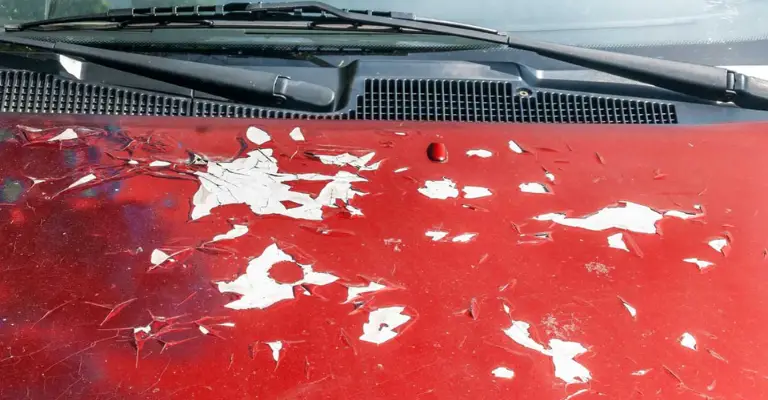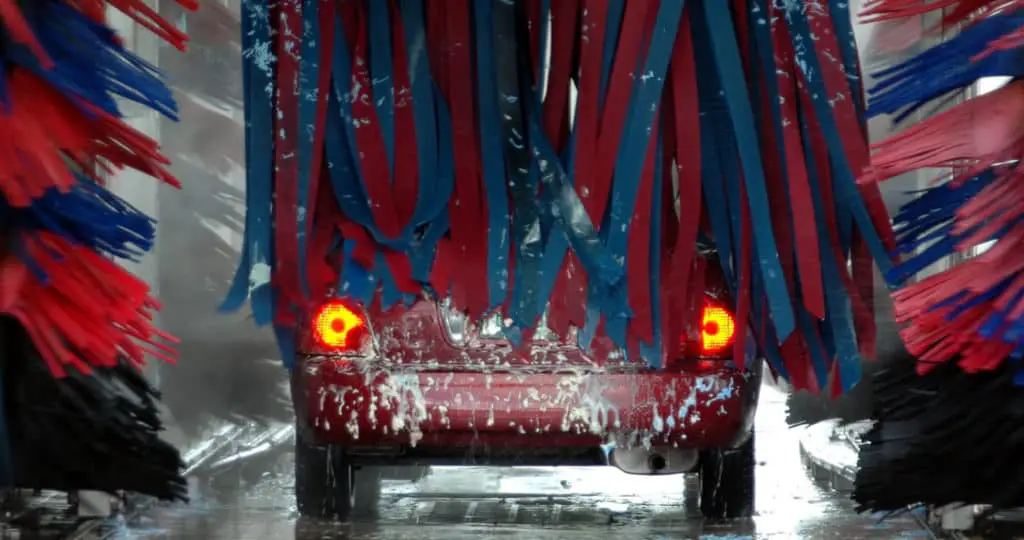- How to Clean Car Carpets Quickly (Without An Extractor) - July 10, 2024
- Can You Touch Up Clear Coat On A Car? Yes and No (Here’s Why) - November 25, 2023
- How To Wax A Car By Hand (For Beginners) - November 14, 2023
Last Updated on January 16, 2025 by Nate Schnell
Accidentally spilling brake fluid on your car’s paintwork is a common mishap, but it can lead to significant damage if not promptly addressed. Understanding the effects of brake fluid, how to remove it safely, and the potential consequences of leaving it untreated can help you prevent costly repairs and protect your vehicle’s appearance.
Understanding Brake Fluid
Brake fluid is a hydraulic liquid essential for your car’s braking system. Most modern brake fluids are glycol-ether based, although some higher-performance fluids use silicone or mineral oil. The chemical properties that make brake fluid effective in maintaining pressure also make it hazardous to your car’s paint.
When brake fluid comes into contact with your car’s paint, the glycol-ether compounds act as a solvent, starting a chemical reaction that can break down the protective clear coat and underlying paint layers.
How Brake Fluid Damages Car Paint
The damaging process begins almost immediately after exposure. Here’s a breakdown of what happens:
- Initial Contact (Less than 5 Minutes): In the first few minutes, the brake fluid may not cause visible damage if wiped away quickly. However, the chemical reaction has already begun.
- 5 to 10 Minutes: At this stage, the protective clear coat weakens, and you may notice dull spots or discoloration.
- Beyond 30 Minutes: The brake fluid can penetrate deeper, causing severe damage such as bubbling, streaking, and erosion. In extreme cases, the paint may be completely stripped down to the bare metal, leaving the surface vulnerable to rust.
Preventing Brake Fluid Spills
Prevention is always better than cure. Here are some tips to minimize the risk of accidental spills:
- Wear Protective Gloves: Use disposable latex or nitrile gloves to ensure a steady grip and avoid spills.
- Use a Barrier Cloth: Place a clean cloth or absorbent pad around the brake fluid reservoir to catch any drips during maintenance.
- Be Mindful of Your Movements: Slow, careful movements reduce the likelihood of accidental spills.
- Have Cleaning Supplies Ready: Keep a clean rag, water, and mild car soap nearby so you can address any spills immediately.
Steps to Remove Brake Fluid from Car Paint
If brake fluid spills onto your car’s paintwork, swift action is crucial. Here’s how to clean it up safely:
1. Blot the Fluid
Use a clean, soft towel or rag to gently blot the affected area. Avoid rubbing, as this can spread the fluid and increase damage.
2. Rinse with Water
Rinse the area thoroughly with cool water to dilute and wash away any remaining fluid. Be gentle, especially if the paint is older or already compromised.
3. Clean with Car Soap
After rinsing, apply a high-quality car soap with a soft sponge or microfiber mitt. Gently scrub the area in a circular motion and rinse again with clean water.
4. Dry with a Microfiber Towel
Dry the surface with a microfiber towel to prevent water spots and inspect the area for any lingering damage.
Addressing Brake Fluid Damage
If brake fluid exposure has caused visible damage, you may need professional help. Here’s what to consider based on the severity of the damage:
Mild Damage
For minor issues like dull spots or faint streaks, touch-up paint and clear coat restorers can be effective. A professional detailer can often blend the affected area to restore the paint’s original appearance.
Severe Damage
In cases where the clear coat has eroded and exposed the base coat or bare metal, a complete paint repair may be necessary. This typically involves sanding down the damaged area, applying primer, repainting, and sealing with a new clear coat. It’s crucial to use a reputable auto body shop to ensure a high-quality finish.
Preventive Maintenance for Long-Term Protection
To protect your car from future incidents, consider the following:
- Ceramic Coating: A ceramic coating provides an additional layer of protection, making the paint surface more resistant to chemical damage.
- Regular Inspections: Routinely inspect your car’s paint for small chips or cracks that can worsen if exposed to chemicals.
- Keep Emergency Supplies: Store a microfiber towel, car soap, and water in your trunk for quick cleanups on the go.
Frequently Asked Questions
What are the consequences of brake fluid spills on car paint?
Brake fluid can weaken and erode the clear coat, leading to discoloration, bubbling, and exposure of the underlying metal if not cleaned promptly. Over time, this can cause rust and significantly devalue your vehicle.
How quickly should I clean up brake fluid spills?
Immediately. Ideally, the brake fluid should be cleaned within five minutes to prevent visible damage.
Can I repair brake fluid damage myself?
Minor issues can often be fixed with touch-up paint or clear coat restorers, but severe damage requires professional evaluation and repair to ensure the paintwork is restored correctly.
Final Thoughts
Brake fluid is essential for your car’s safety, but it’s important to handle it carefully to avoid damaging your car’s paintwork. In the event of a spill, swift and proper cleaning can prevent costly repairs and maintain the integrity of your vehicle’s appearance. With a little preparation and mindfulness during maintenance tasks, you can minimize the risk of accidental spills. And if damage does occur, addressing it promptly can make all the difference in preserving your car’s value.



